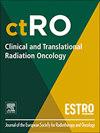Trends in use of magnetic resonance imaging and partial breast irradiation between 2011–2022 in the Netherlands: A population-based study
IF 2.7
3区 医学
Q3 ONCOLOGY
引用次数: 0
Abstract
Purpose
This study aimed to investigate whether the introduction of partial breast irradiation (PBI) was associated with increased MRI use in the Netherlands from 2011 to 2022, and examined the impact of MRI on treatment and outcomes.
Methods
Women aged ≥50 who underwent surgery (without preoperative systemic therapy) for cT1-2N0M0 breast cancer or DCIS between 2011 and 2022 were selected from the Netherlands Cancer Registry. Logistic regression was used to analyze associations between MRI and treatment or surgical radicality, stratified by tumour type. Subgroup analyses were performed in patients meeting ASTRO PBI criteria (unifocal cT1, grade 1/2, ER-positive, pure DCIS ≤ 2,5 cm).
Results
Among 119,768 patients, 35,863 (30 %) received MRI, increasing from 24 % (2011) to 37 % (2022). PBI use increased from 3 % (2017) to 21 % (2022). MRI was not associated with the probability of receiving PBI (OR 0.98, 95 % CI:0.90–1.07). In patients with invasive breast cancer, MRI was associated with fewer DCIS-involved margins (OR 0.81, 95 % CI:0.74–0.89), but a higher probability of mastectomy (OR 1.29, 95 % CI:1.24–1.34). In patients with an ASTRO-defined PBI indication, MRI use was associated with a decreased likelihood of receiving PBI in invasive cancer (OR:0.66, 95 % CI:0.60–0.72) and DCIS (OR:0.80, 95 % CI:0.75–0.85).
Conclusion
This study shows rising trends in PBI and MRI use in the Netherlands from 2011 to 2022. MRI reduced PBI eligibility and enhanced surgical precision by less involved margins in patients with cT1N0 breast cancer without PST.
2011-2022年荷兰磁共振成像和部分乳房放疗的使用趋势:一项基于人群的研究
目的本研究旨在调查2011年至2022年荷兰部分乳房照射(PBI)的引入是否与MRI使用增加有关,并检查MRI对治疗和结果的影响。方法从荷兰癌症登记处选择2011年至2022年期间接受cT1-2N0M0乳腺癌或DCIS手术(术前未进行全身治疗)的年龄≥50岁的女性。采用逻辑回归分析MRI与治疗或手术根治性之间的关系,并按肿瘤类型分层。对符合ASTRO PBI标准的患者进行亚组分析(单灶cT1, 1/2级,er阳性,单纯DCIS≤2.5 cm)。结果119,768例患者中,35,863例(30%)接受了MRI检查,从2011年的24%增加到2022年的37%。PBI的使用从3%(2017年)增加到21%(2022年)。MRI与接受PBI的概率无关(OR 0.98, 95% CI: 0.90-1.07)。在浸润性乳腺癌患者中,MRI与较少的dcis累及边缘相关(OR 0.81, 95% CI: 0.74-0.89),但与更高的乳房切除术概率相关(OR 1.29, 95% CI: 1.24-1.34)。在具有astro定义的PBI指征的患者中,MRI使用与侵袭性癌症(OR:0.66, 95% CI: 0.60-0.72)和DCIS (OR:0.80, 95% CI: 0.75-0.85)接受PBI的可能性降低相关。本研究显示2011年至2022年荷兰PBI和MRI使用呈上升趋势。MRI降低了无PST的cT1N0乳腺癌患者的PBI资格,并提高了手术精度。
本文章由计算机程序翻译,如有差异,请以英文原文为准。
求助全文
约1分钟内获得全文
求助全文
来源期刊

Clinical and Translational Radiation Oncology
Medicine-Radiology, Nuclear Medicine and Imaging
CiteScore
5.30
自引率
3.20%
发文量
114
审稿时长
40 days
 求助内容:
求助内容: 应助结果提醒方式:
应助结果提醒方式:


